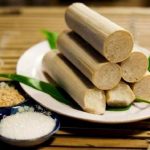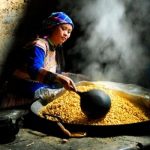More Than Just Happy Water: Discover the Ethnic Diversity of the Ha Giang Loop
By admin
Post Views: 49
More Than Just Happy Water: Discover the Ethnic Diversity of the Ha Giang Loop
At Lazy Cat Homestay, we often hear travelers describe the Ha Giang Loop as “just a wild ride filled with shots of happy water and late-night parties.”
And while we won’t deny that sharing a few rounds of local rice wine can lead to great memories, there’s so much more to this experience than just the party scene.
Nestled among Ha Giang’s dramatic karst peaks are villages and communities that offer a rare glimpse into the heart of Vietnam’s cultural heritage. The Ha Giang Loop is a journey through not only stunning landscapes but also the rich traditions of more than 20 unique ethnic groups.
If you’re ready to see this spectacular region through a deeper, more meaningful lens, let us introduce you to the real soul of the Loop.
How Many Ethnic Groups Live in Ha Giang?
When it comes to cultural diversity, Ha Giang province stands out as one of Vietnam’s most ethnically rich regions. According to the latest statistics, 19 different ethnic groups call this mountainous area home.
What makes Ha Giang even more unique is that nearly 90% of the population belongs to ethnic minority communities—a rare statistic compared to the rest of Vietnam, where the Kinh (ethnic Vietnamese) form the majority.
Who Lives in Ha Giang? Here’s a Quick Breakdown:
Hmong – 32.9%
The largest ethnic group in Ha Giang, known for their colorful textiles, traditional farming practices, and highland village life.Tay – 23.2%
Typically found in lowervalleys, the Tay are Vietnam’s second-largest ethnic minority, famous for their stilt houses and rich musical traditions.
Dao (Yao) – 14.9%
Recognizable by their red headdresses and herbal medicine traditions, the Dao contribute significantly to the region’s cultural fabric.Kinh (ethnic Vietnamese) – 12.8%
While they make up the majority of Vietnam’s national population, the Kinh are a minority in Ha Giang.Nung – 9.7%
Known for their agricultural expertise and community festivals, the Nung often live near the Chinese border in northern Ha Giang.Other ethnic groups – The remaini
ng percentage includes smaller but equally vibrant groups such as the Lo Lo, Pa Then, Giay, Pu Peo, La Chi, and more.
Why It Matters
Each of these groups brings its own language, traditional clothing, customs, festivals, and ways of life. From ancient rituals to handwoven fabrics and mountain farming techniques, Ha Giang is a living museum of ethnic diversity.
This rich cultural mix is one of the key reasons why a Ha Giang Loop tour is so much more than just a scenic ride—it’s an opportunity to engage with communities whose traditions have been passed down for generations.
Meet the People Behind the Views
Ready to go beyond the typical travel experience? At Lazy Cat Homestay, we believe that the most unforgettable part of the Ha Giang Loop is not just the mountains or motorbikes—it’s the people. Join us to learn more about the diverse ethnic groups of Ha Giang, their stories, and their way of life.
Let’s dive deeper. Let’s travel meaningfully.
The Hmong People of Ha Giang: Keepers of the Mountains
If you’ve admired the breathtaking terraced rice fields of Ha Giang, you’ve likely seen the legacy of the Hmong people, the province’s largest and one of its most influential ethnic groups.
Descendants of migrants who journeyed from southern China centuries ago, the Hmong settled in Vietnam’s rugged northern mountains to seek freedom, autonomy, and a land where they could preserve their customs. Today, they continue to thrive in some of the most remote and stunning parts of Ha Giang.
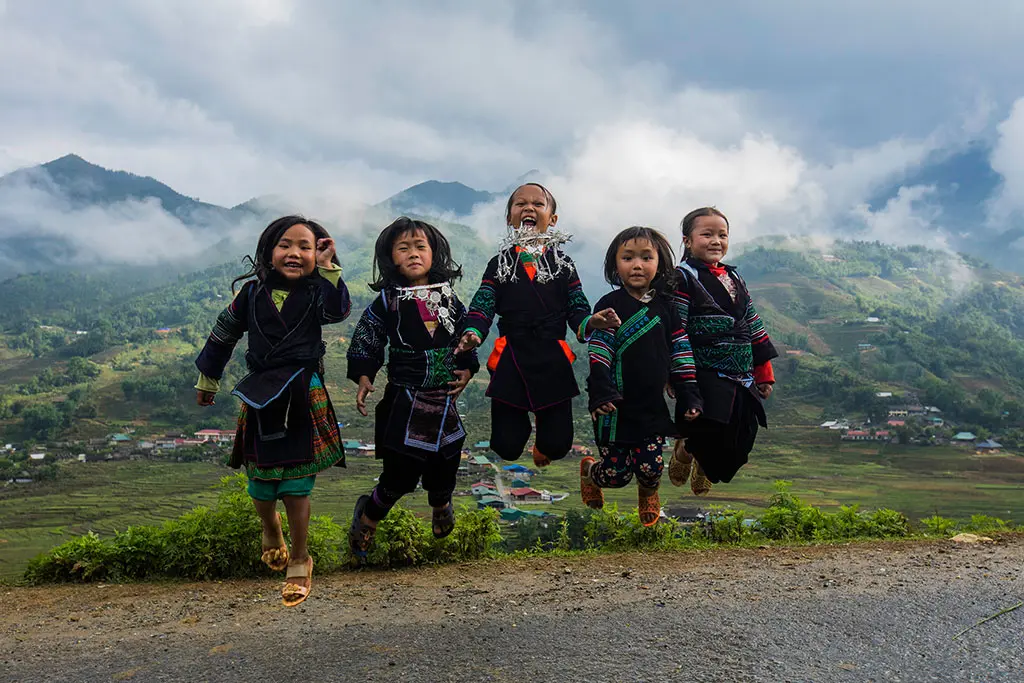
What Makes the Hmong Unique?
The Hmong people are not just farmers or artisans—they are guardians of tradition, carrying forward a culture that’s as rich as the landscapes they inhabit.
Vibrant Handcrafted Clothing
Hmong attire is instantly recognizable. Women wear hand-embroidered outfits adorned with floral and geometric patterns, often in rich indigo or bright hues. These clothes are more than fashion—they tell stories of ancestry, village life, and identity.
The Khèn Flute
The khèn is a bamboo mouth organ with six pipes, used in courtship rituals, festive dances, and even funerals. Its haunting, melodic tone is deeply woven into the rhythm of Hmong life.
A Deep Sense of Community
Hmong villages are built around family and community. It’s common to find multiple generations living under one roof, gathering around a fire to share meals, folk tales, and oral history that’s passed down like an heirloom.
Farming with Resilience
Working some of the steepest and most unforgiving terrain in Vietnam, the Hmong have become masters of mountain agriculture. They cultivate corn, rice, hemp, and medicinal herbs using techniques adapted over centuries.
Where to Experience Hmong Culture in Ha Giang
Want to connect with Hmong culture in a meaningful way? Head to Meo Vac’s Sunday Market, one of the most authentic ethnic markets in northern Vietnam.
You’ll find:
Colorful Hmong textiles and traditional clothing
Locally grown produce and medicinal herbs
Lively barter and trade of livestock
A unique window into rural mountain life you won’t find anywhere else
Travel Tip:
Consider staying at a local homestay like Lazy Cat Homestay in Ha Giang. Many host families are connected to Hmong communities and can help arrange cultural experiences or guided visits to villages where tourism is still respectful and immersive.
The Tay People of Ha Giang: Masters of the Valleys
While the Hmong dominate the high mountain slopes, the Tay people are the heart and soul of Ha Giang’s fertile valleys. As you journey along the Ha Giang Loop, it’s hard to miss their elegant stilt houses, which rise above lush rice paddies and winding streams—symbols of harmony between people and nature.
The Tay are Vietnam’s second-largest ethnic minority, and their presence in Ha Giang offers a unique glimpse into a culture rooted in agriculture, music, and strong community values.
What Makes the Tay Unique?
The Tay people live in close-knit villages where tradition and nature blend seamlessly. Here’s what sets them apart:
Agricultural Expertise
The Tay are exceptional farmers, especially skilled in wet rice cultivation and fish farming. Their methods have been passed down for generations and remain vital to both their culture and local economy.
Stilt House Architecture
Their traditional stilt houses are designed to adapt to valley environments. Built using timber and bamboo, these homes are elevated to stay cool, dry, and safe from floods. The space beneath the house is often used to keep animals or store farming tools.
Then Singing
A cornerstone of Tay spiritual and cultural life, Then singing is a form of ceremonial music used in rituals that honor ancestors and communicate with deities. It is often accompanied by traditional instruments and costumes, offering a powerful window into Tay beliefs.
Simple and Elegant Clothing
The Tay prefer indigo-dyed garments with subtle embroidery. Their style reflects a minimalist aesthetic—practical yet graceful, with garments that suit both daily work and ceremonial life.
A Taste of Tay Hospitality
If you’re lucky enough to be welcomed into a Tay home, you’re in for a treat. Meals often include sticky rice, grilled river fish, fresh bamboo shoots, and seasonal herbs—simple ingredients that reflect the richness of the land.
The Dao People of Ha Giang: Guardians of Ancient Wisdom
Among the many ethnic groups you’ll encounter along the Ha Giang Loop, the Dao people stand out—literally. With their vivid red headscarves, layered garments, and detailed silver jewelry, the Dao are one of the most visually striking communities in the region.
But their distinctive appearance is just the beginning. The Dao people possess a rich spiritual and medicinal heritage, making them one of the most culturally fascinating groups in Ha Giang.
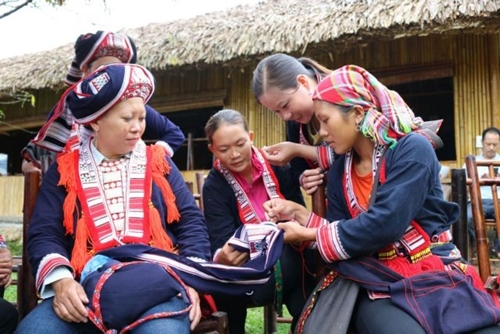
Why the Dao Are Culturally Unique
From spiritual rituals to traditional healing, the Dao have maintained many of their ancestral customs despite rapid modernization around them.
Spiritual Beliefs and Taoist Influence
The Dao practice a blend of Taoism and animist traditions, creating a complex spiritual world centered around ancestor worship, nature spirits, and sacred texts. Their belief system shapes everything from home construction to daily rituals.
Cap Sac: A Powerful Rite of Passage
One of the Dao’s most important ceremonies is the Cap Sac—a coming-of-age ritual for young men. These events are dramatic and deeply symbolic, often involving night-long chanting, drumming, ceremonial costumes, and firelight rituals. It signifies a man’s readiness to serve his community and take on spiritual responsibilities.
Masters of Herbal Medicine
The Dao are renowned for their herbal knowledge, passed down through generations. From herbal steam baths to remedies for muscle pain and fatigue, Dao healers continue to practice natural medicine rooted in forest ecology and traditional wisdom.
Sacred Homes and Carvings
Dao homes are more than just shelters—they’re spiritual spaces. Often decorated with carved wooden symbols and protective charms, these houses reflect both artistic expression and religious devotion. The placement of altars, doorways, and sleeping areas follows spiritual principles tied to harmony and protection.
Where to Experience Dao Culture
For a true glimpse into Dao life, head to Hoang Su Phi, a region famous for its spectacular terraced rice fields and well-preserved Dao villages. Here, you’ll witness traditional farming techniques, spiritual rituals, and everyday practices that haven’t changed much in centuries.
The Lo Lo People of Ha Giang: Echoes of an Ancient Legacy
Among the many ethnic groups in Ha Giang, the Lo Lo people stand out not for their numbers, but for their deep cultural roots and rare traditions. As one of the province’s smallest ethnic minorities, the Lo Lo have fiercely preserved a heritage that dates back thousands of years.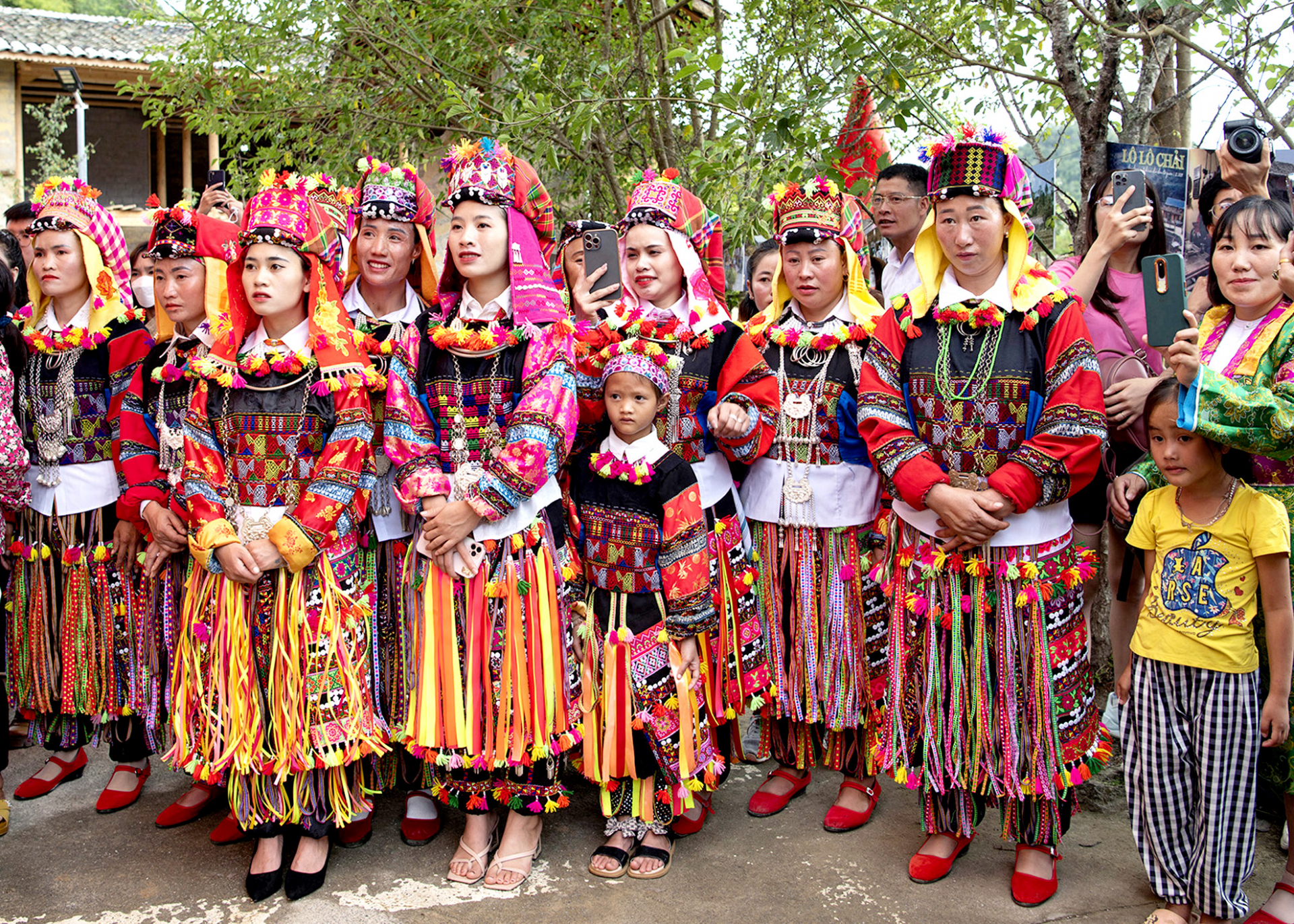
What Makes the Lo Lo Special?
Despite their modest population, the Lo Lo are cultural custodians of ancient practices and artistry:
Keepers of the Bronze Drum
The bronze drum holds sacred significance in Lo Lo culture. Used in rain-calling ceremonies, ancestor worship, and spiritual festivals, it is a powerful symbol of their connection to nature and the divine.
Distinctive Vocal Traditions
The Lo Lo are known for their polyphonic singing, a form of traditional music involving multiple vocal parts. The result is a hauntingly beautiful sound that’s both ceremonial and deeply emotive.
Stone House Architecture
Unlike other groups who build with wood or bamboo, the Lo Lo construct robust stone houses designed to withstand harsh mountain weather. These homes are not only practical but architecturally unique, reflecting both strength and tradition.
Where to Experience Lo Lo Culture
For those riding the Ha Giang Loop, stop in Dong Van, where you may catch a Lo Lo cultural performance, particularly during local festivals or community gatherings. Visiting a Lo Lo village offers a rare look into one of Vietnam’s most endangered but resilient cultures.
The Nung People of Ha Giang: Artisans of the Highlands
Though smaller in number than the Hmong or Tay, the Nung people bring their own rich contributions to the cultural mosaic of Ha Giang. Known for their skillful craftsmanship and clay house architecture, the Nung have created a way of life that blends tradition, sustainability, and artistry.
What Makes the Nung Stand Out?
The Nung people are deeply tied to the land, with customs and skills passed down through countless generations.
Clay House Construction
Their signature baked clay houses are marvels of sustainable design. Weather-resistant and thermally efficient, these structures are both beautiful and built to last—perfect for life in the northern highlands.
Weaving and Blacksmithing
The Nung are skilled artisans, particularly in weaving textiles and forging tools and weapons. These crafts are often practiced communally and play an essential role in both daily life and ceremonial events.
Traditional Agriculture
Rice farming remains at the heart of Nung society. Their centuries-old techniques reflect a deep understanding of the environment and seasonal cycles, and are still widely practiced today.
Where to Discover Nung Culture
To fully experience Nung heritage, visit Quan Ba District, where traditional villages dot the valleys and hillsides. Here, you can explore their distinctive homes, enjoy local cuisine, and perhaps even sample their famous homemade rice wine—often shared with a warm smile and an open door.
Challenges Facing the Ethnic Groups in Ha Giang
For centuries, the ethnic minority groups of Ha Giang have lived in harmony with the land, preserving traditions that stretch back generations. But today, their way of life is at a crossroads.
As globalization, economic change, and tourism reach deeper into Vietnam’s remote northern provinces, these communities are facing a mix of opportunities and growing threats to their cultural integrity.
The Pressures of Modernization
While modern infrastructure and tourism have brought roads, income, and new opportunities, they have also introduced complex challenges:
Cultural Commercialization
Traditional clothing, once worn with deep cultural and spiritual significance, is now often mass-produced for tourists. As a result, some garments are losing their symbolic meaning and craftsmanship.
Youth Migration
Many young people are leaving their villages in search of education and work in cities. While this opens doors for the future, it often leads to a decline in language use, oral traditions, and community rituals, as the younger generation becomes disconnected from their roots.
Tourism: Boon or Burden?
The rise of tourism in Ha Giang brings vital income to families and communities—but it also has downsides. In some areas, cultural performances are staged solely for visitors, and daily life is adjusted to fit tourist expectations, potentially diluting authenticity.
Preserving Culture Through Sustainable Solutions
The good news is that local communities, NGOs, and cultural preservation initiatives are stepping up to protect these living heritages:
Sustainable tourism programs aim to provide meaningful cultural exchanges while minimizing disruption to daily life.
Artisan cooperatives help ethnic minority women sell traditional textiles, embroidery, and handicrafts at fair prices—supporting both income and cultural continuity.
Cultural education projects are teaching young people the importance of their language, stories, and rituals, ensuring they’re passed on to future generations.
What You Can Do as a Traveler
If you’re visiting Ha Giang, you can be part of the solution:
Choose responsible tours and local homestays that work directly with ethnic communities.
Buy handmade products directly from artisans instead of from tourist markets.
Learn before you go—understanding the traditions of the people you’re visiting leads to more respectful and enriching experiences.
By supporting cultural preservation over exploitation, travelers can help ensure that Ha Giang’s incredible diversity isn’t just something to admire today—but something that survives for generations to come.
Tips for Visiting the Ethnic Groups on the Ha Giang Loop
Exploring the Ha Giang Loop offers more than stunning mountain scenery—it’s a chance to engage with some of Vietnam’s most culturally rich and welcoming communities. But to truly connect, it’s important to approach each encounter with respect, sensitivity, and curiosity.
Here are a few practical and respectful tips to help you navigate these meaningful cultural exchanges:
1. Respect the Local Culture
Ha Giang is home to over 19 ethnic groups, each with its own distinct traditions, customs, and values. Treating these communities with respect ensures that your visit is both positive and appreciated.
2. Mind Your Manners
You’re not just a tourist—you’re a guest.
Always ask permission before taking photos of people, especially in markets or villages.
If you’re invited into a home, accept with gratitude, and follow your host’s lead when it comes to rituals or customs.
Learn a few polite phrases in Vietnamese or the local language—it’s a small gesture that goes a long way.
3. Dress Appropriately
Opt for modest clothing that covers shoulders and knees, especially when visiting remote villages or entering homes.
Avoid flashy or revealing outfits, which may seem disrespectful in more traditional areas.
If attending a ceremony or festival, ask your guide or host if there’s a specific dress code to follow.
4. Tread Lightly
Ha Giang’s rice terraces and pathways are not just scenic—they’re essential to local survival.
Stick to trails and paths to avoid damaging crops or private land.
Don’t pick plants or disturb farming equipment.
Leave no trace—bring your trash with you and avoid using single-use plastics.
5. Respect the Local Rhythm
Life in Ha Giang follows a slower, more intentional pace. Villagers may be busy farming, resting, or simply enjoying quiet time with family.
Don’t expect tourist-style hospitality everywhere—what may feel like distance is often shyness or privacy, not unfriendliness.
A little patience and genuine interest can lead to heartfelt interactions and unforgettable moments.
6. Support the Local Economy
Choose to stay in family-run homestays, buy handmade crafts, and eat at local eateries. Your support helps keep traditions alive and brings direct benefits to the people you’re visiting.
Travel With Purpose
The more you understand and respect the people of Ha Giang, the more meaningful your journey will be. Cultural respect isn’t just about politeness—it’s about preserving the integrity of places and people that make the Ha Giang Loop truly special.
Dive Into the Local Markets: The Heartbeat of Ha Giang’s Ethnic Communities
One of the best ways to truly experience the vibrant culture of Ha Giang’s ethnic groups is by visiting the bustling local markets. Think of these markets as lively weekly block parties where the entire community comes together to trade, socialize, and celebrate their traditions.
Market Magic in Meo Vac and Dong Van
Markets in towns like Meo Vac and Dong Van are more than just places to shop—they’re cultural hubs where diverse ethnic groups gather to sell handmade crafts, fresh produce, and traditional foods.
Taste the local flavors: From savory grilled meats to sweet rice cakes, these markets offer an array of exotic street foods that give you a genuine taste of the region.
Shop for unique souvenirs: Look for intricate textiles, embroidered clothing, and silver jewelry crafted by local artisans.
Enjoy the atmosphere: The energy is contagious, filled with music, laughter, and the lively banter of vendors and visitors alike.
Bargain with a Smile
Haggling is part of the market experience in Ha Giang, but always do so politely and with a smile. Vendors appreciate respectful bargaining, and it can even open doors to deeper conversations.
Don’t hesitate to ask questions about the products—you might uncover fascinating stories about local customs or craftsmanship.
Occasionally, a friendly chat might even lead to an invitation to a nearby festival or cultural event.
Embrace the Local Lingo: Speak the Language of Connection
While most travelers know basic Vietnamese greetings like “Xin chào” (hello) and “Cảm ơn” (thank you), the true magic happens when you learn a few words in the local ethnic dialects.
Many of the drivers, guides, and hosts you meet on the Ha Giang Loop are themselves members of these ethnic groups and can teach you simple phrases.
Even saying a basic greeting or thank you in Hmong, Tay, Dao, or Nung languages shows respect and can spark warm smiles and goodwill.
Trying out local words demonstrates your genuine interest in the culture, making interactions more meaningful and memorable.
Pro Tip: Ask Your Guide or Host for Help
If you’re unsure where to start, just ask your tour driver or your homestay host—like those at Lazy Cat Homestay—for a few common phrases. They’ll be happy to help you connect with the local community through language.
Frequently Asked Questions (FAQs) About the Ethnic Groups in Ha Giang
Exploring Ha Giang’s diverse ethnic cultures often sparks curiosity. Here are answers to some of the most common questions travelers ask when discovering this unique region:
1. What are the best ethnic markets to visit in Ha Giang?
The most popular markets to experience ethnic culture are the Meo Vac Market and Dong Van Market, both held on Sundays. These vibrant markets offer everything from traditional textiles and embroidered clothing to fresh local produce and livestock, making them perfect spots to immerse yourself in local life.
2. Can I take photos of the locals in Ha Giang?
Photography is a great way to capture memories, but always ask for permission first before taking photos of people. This simple act shows respect and often leads to warmer, more meaningful interactions with locals.
3. Which ethnic groups are the largest in Ha Giang?
The three largest ethnic groups in Ha Giang are the H’mong, Tay, and Dao. Each has its own rich customs, traditional clothing, and cultural practices that contribute to the region’s incredible diversity.
4. Where do Ha Giang’s ethnic minorities typically live?
Most ethnic minorities in Ha Giang reside in rural, mountainous, and valley areas along the Ha Giang Loop. However, you may also find members of these groups living and working in Ha Giang City and other towns.
Our Thoughts on Discovering Ha Giang’s Ethnic Groups
If you’re planning to explore the Ha Giang Loop with Lazy Cat Homestay, you can count on us to introduce you to the incredible ethnic groups that make this region their home.
Expect to visit authentic local villages, engage in heartfelt conversations with diverse communities, share family-style dinners with host families, and exchange high-fives with the passing local children.
Ha Giang is so much more than its winding roads, breathtaking views, or even the famous karaoke nights and “Happy Water.” At its heart, it’s about the people who live in these majestic mountains and the rich cultures they carry forward.
So, book your Ha Giang Loop tour with Lazy Cat Homestay today, and remember: behind every cliffside village, every colorful market stall, and every lush rice terrace, there’s an ethnic group ready to welcome you with a warm smile and a friendly wave.
Ha Giang Loop Tour – Small Group with Lazy Cat Homestay
Explore the stunning landscapes of Northern Vietnam on the Ha Giang Loop Tour with Lazy Cat Homestay – the perfect base for your adventure. Join a small group (6–8 people) for a safe, authentic motorbike journey led by local ethnic guides.
✅ Ride the famous Ma Pi Leng Pass
✅ Visit traditional ethnic minority villages
✅ Choose easy rider or self-drive motorbike options
✅ Stay at our cozy, family-run homestay in Ha Giang City
Whether you’re a solo traveler, a couple, or a group of friends, this is the best Ha Giang Loop experience for those seeking real local culture, breathtaking views, and unforgettable memories.

